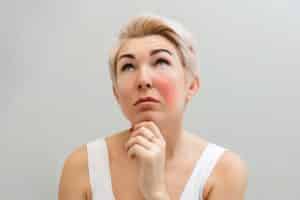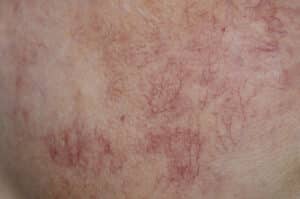Rosacea Treatment in Dallas, TX
Chronic skin issues can be a burden in your day-to-day life, and rosacea is just one of the many conditions that fall into that category. The recurring redness can cause an undue increase in stress and make your skin feel overly sensitive. The millions of Americans who live with rosacea know exactly what we’re talking about.
Thankfully, we live in a new day and age with various clinical treatment options. And if you’re looking for rosacea treatment in Dallas, Texas, then it’s time to take a trip to Dallas Dermatology Treatment and Research Center.
Dallas Dermatology Treatment and Research Center is home to an exceptional team of clinical dermatologists and dermatologic specialists that has helped an ever-increasing number of patients get relief from their rosacea symptoms.
What Is Rosacea?
 Rosacea is a recurring skin condition wherein your skin flares up with redness. This redness typically occurs across the face, centered around the nose, cheeks, and forehead.
Rosacea is a recurring skin condition wherein your skin flares up with redness. This redness typically occurs across the face, centered around the nose, cheeks, and forehead.
However, in more severe cases, the redness caused by rosacea can spread further than that and affect your neck and back. Rosacea can also create symptoms such as oily skin, hypersensitivity in the affected areas, eye discomfort, and more.
Types of Rosacea
In total, there are four distinct types of rosacea. The subtypes are as follows:
- Erythematotelangiectatic Rosacea (Subtype One) — The most common and widely known type of rosacea. It involves the standard rosacea symptoms like facial redness and flushing, as well as more prominent facial blood vessels.
- Papulopustular Rosacea (Subtype Two) — Most commonly affects women over the age of 40 and involves more acne-like breakouts of redness.
- Rhinophyma Rosacea (Subtype Three) — By far the rarest form of rosacea. This condition involves the thickening of your nose skin, and it is most commonly found in men.
- Ocular Rosacea (Subtype Four) — Simply a variation of rosacea that more explicitly or exclusively affects the area around your eyes.
What Causes Rosacea?
As with many skin conditions, the direct causes of rosacea are still fairly unknown. However, there are countless professionals around the world — like our clinical dermatologists in Dallas, TX, here at Dallas Dermatology Treatment and Research Center — who work tirelessly to find more answers. As of now, we know that rosacea can be caused by:
- Genetics
- Immune system defects
- Skin mites called Demodex
- The infectious intestinal bug H. pylori
- The overabundance of Cathelicidin, which is a protein that fights off skin infection
Treatment for Rosacea
 For lighter cases of rosacea, our clinical dermatologists here at Dallas Dermatology Treatment and Research Center can offer minimally invasive treatments such as topical medications, oral antibiotics, and acne medications to help clear up rosacea.
For lighter cases of rosacea, our clinical dermatologists here at Dallas Dermatology Treatment and Research Center can offer minimally invasive treatments such as topical medications, oral antibiotics, and acne medications to help clear up rosacea.
However, for more severe cases, it may be necessary to perform laser treatment or clinical trials to find a solution. There are also a number of lifestyle adjustments and at-home habits that Dr. Radusky may recommend in order to further aid in the treatment of your rosacea.
Triggers That Worsen Rosacea
Knowing your triggers can help you avoid them and better manage your rosacea symptoms. Common triggers include:
- Hot or cold weather
- Spicy foods or alcohol
- Stress and emotional changes
- Sun exposure
- Certain skincare products
Why Choose Dallas Dermatology Treatment and Research Center?
At Dallas Dermatology Treatment and Research Center, we provide expert dermatologic care with personalized solutions. Our team uses advanced treatment technologies and years of experience to address a wide range of skin, hair, and nail concerns, from routine issues to complex conditions.
Dr. Ross Radusky is our board-certified dermatologist specializing in medical and cosmetic dermatology, including acne, eczema, skin cancer screenings, Botox, and laser resurfacing. His extensive training at leading institutions ensures high-quality outcomes. Heather Bailey, APRN, NP-C, complements this expertise with 20 years of experience in family medicine and dermatology. Together, they deliver reliable dermatologic solutions in our welcoming environment.
Frequently Asked Questions
How Does Laser Treatment Help With Rosacea?
Laser treatment helps by targeting and reducing the appearance of redness and visible blood vessels caused by rosacea. The focused light energy breaks down dilated blood vessels under the skin, shrinking them and minimizing redness over time. It also improves skin texture and can smooth areas of thickened skin. While not a cure, laser therapy provides long-term relief and reduces the frequency and severity of rosacea flare-ups.
Can Rosacea Go Away on Its Own?
No, rosacea does not go away on its own. It is a chronic condition that requires treatment to manage symptoms and prevent progression. Early intervention can greatly improve skin health.
Can Stress Make Rosacea Worse?
Stress is a common trigger for rosacea flare-ups. Managing stress with relaxation techniques and mindfulness may help reduce symptoms. Identifying these triggers will be a key part of your treatment.
How Is Rosacea Diagnosed?
Rosacea is typically diagnosed through a skin examination by a dermatologist. Medical history and symptom patterns also help confirm the condition. Additional tests are rarely needed.
Are Men and Women Affected by Rosacea Differently?
Men and women experience rosacea differently, with men more prone to thickened skin (rhinophyma) and women more likely to have redness and acne-like symptoms. Both benefit from proper treatment. Hormonal factors can also influence these differences.
What Happens If Rosacea Is Left Untreated?
Untreated rosacea may worsen, causing permanent redness, visible blood vessels, or thickened skin. Early care helps prevent long-term damage. Severe cases may require more intensive interventions like laser therapy.
Clear Up Your Rosacea Today!
The best way to find the right treatment for rosacea in Dallas, TX, is to reach out to our friendly team here at Dallas Dermatology Treatment and Research Center. Just give us a call at 972-661-2729, and Dr. Radusky will be happy to answer any questions you may have. You can also book your next appointment easily via our convenient online form!